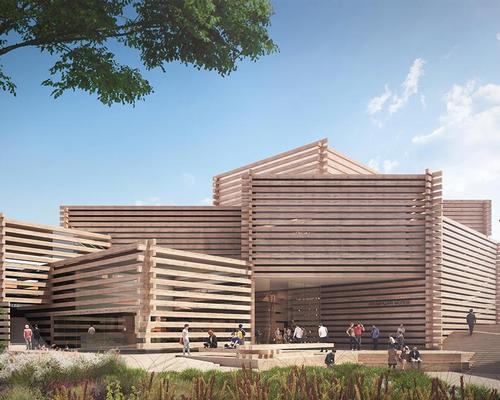19 Apr 2017
Kengo Kuma designs Turkish modern art museum formed of stacked wooden boxes
BY Kim Megson

The ever-busy architecture practice of Kengo Kuma have added yet another large-scale leisure project to their growing slate of work: the Odunpazari Modern Art Museum in the Turkish city Eskisehir.
A series of overlapping stacked wooden volumes will form the 3,582sq m (38,500sq ft) museum building, which will display collections of Turkish contemporary art.
Located in a recently developed area of the city’s Odunpazari district – which is known for its traditional Ottoman wooden houses – the structure is at its highest at the middle point so as not to disrupt the the continuity of the surrounding streetscape and its small buildings.
The volumes are of different sizes, providing diverse exhibition spaces inside the structure. The galleries on the ground floor can accommodate large scale installations, events and exhibitions, while the smaller upper floor will be tailored to showcase private collections. A skylight at the heart of a central atrium will allow light to reach each of the building’s floors.
“We attempted to design the new museum so as to reflect the small scale of the surrounding houses and to avoid being buried in among the urban scale,” said Kengo Kuma and Associates in a statement. “The place name ‘Odunpazari’ comes from the Turkish word meaning ‘wood market’, and the buying and selling of timber was important here in the past.
“The outer wall of the museum is made of wood all over, linking the building with the history of this land.”
Kuma is working on several museum projects across the world, including the Hans Christian Andersen Museum in Odense, Denmark; the Museum of Indigenous Knowledge in Manilla, the Philippines; and the Victoria & Albert Museum’s offshoot in Dundee, UK.
Speaking to CLAD last year, he revealed he is inspired to design museums because “the role of architects in the 21st century is to create a link between people and art”.
He said: “We should be the communicators between those two things. We have a responsibility to society not to allow isolation.
“In the last century, museums became separated from the culture around them. Now the best new ones are reconnecting with local life. I think they should be part of their street and neighbourhood surroundings.”
Close Window